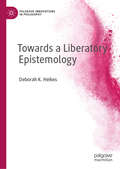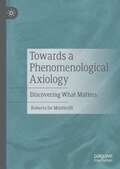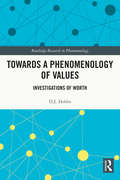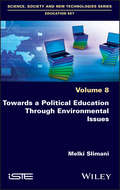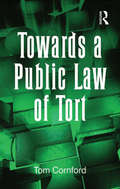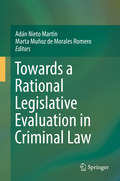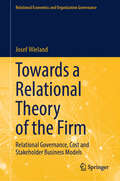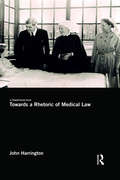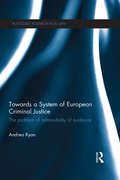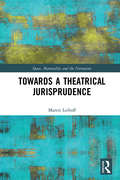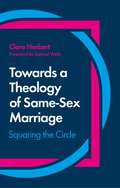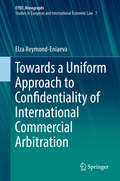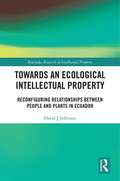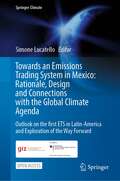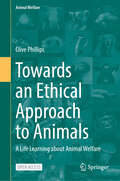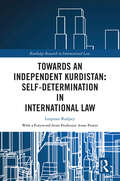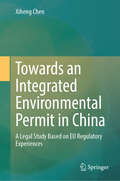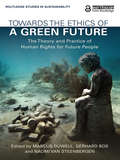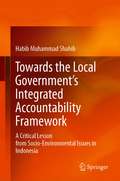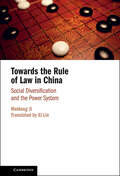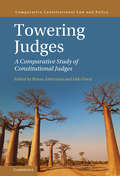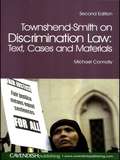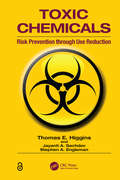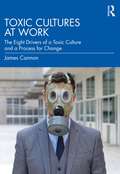- Table View
- List View
Towards a Liberatory Epistemology (Palgrave Innovations in Philosophy)
by Deborah K. HeikesThis book offers a compelling examination of our moral and epistemic obligations to be reasonable people who seek to understand the social reality of those who are different from us. Considering the oppressive aspects of socially constructed ignorance, Heikes argues that ignorance produces both injustice and epistemic repression, before going on to explore how our moral and epistemic obligations to be understanding and reasonable can overcome the negative effects of ignorance. Through the combination of three separate areas of philosophical interest- ignorance, understanding, and reasonableness- Heikes seeks to find a way to correct for epistemological and moral injustices, satisfying needs in feminist theory and critical race theory for an epistemology that offers hope of overcoming the ethical problem of oppression.
Towards a Phenomenological Axiology: Discovering What Matters
by Roberta De MonticelliThis book attempts to open up a path towards a phenomenological theory of values (more technically, a phenomenological axiology). By drawing on everyday experience, and dissociating the notion of value from that of tradition, it shows how emotional sensibility can be integrated to practical reason. This project was prompted by the persuasion that the fragility of democracy, and the current public irrelevance of the ideal principles which support it, largely depend on the inability of modern philosophy to overcome the well-entrenched skepticism about the power of practical reason. The book begins with a phenomenology of cynical consciousness, continues with a survey of still influential theories of value rooted in 20th century philosophy, and finally offers an outline of a bottom-up axiology that revives the anti-skeptical legacy of phenomenology, without ignoring the standards set by contemporary metaethics.
Towards a Phenomenology of Values: Investigations of Worth (Routledge Research in Phenomenology)
by D.J. HobbsThis book provides a framework for phenomenological axiology. It offers a novel account of the existence and nature of values as they appear in conscious experience. By building on previous approaches, including those of Edmund Husserl, Max Scheler, and Nicolai Hartmann, the author develops a unique account of what values really are. After explicating and defending this account, he applies it to several of the most difficult questions in axiology: for example, how our experiences of value can differ from those of others without reducing values to subjective judgments or how the values we experience are connected to the volitional acts that they inspire. This provides satisfactory answers to certain fundamental questions concerning the basic structure of value-experiences. Accordingly, this book represents a novel step forward in phenomenological axiology. Towards a Phenomenology of Values will be of interest to scholars and advanced students working in phenomenology and value theory.
Towards a Political Education Through Environmental Issues
by Melki SlimaniThe growing field of political education through environmental issues is organized around processes, which reach beyond the formal ones found in academic disciplines and national curricula into informal processes (such as social mobilization) and nonformal processes (such as those found in various international educational recommendations). Using theoretical approaches from the fields of political philosophy and the social sciences, this book develops a simultaneously conceptual and analytical framework for the political in educational content involving environmental issues. This framework is then used to empirically analyze educational content on sustainable development formulated by UNESCO, as well as the Tunisian curriculum. The theoretical and empirical studies carried out in this book lead to proposed curriculum tags for political education through environmental issues, with the intent of opening this field to inclusion in the didactics of curriculum research.
Towards a Public Law of Tort
by Tom CornfordPresenting a new approach to the problem of public authority liability, this volume provides a theoretical foundation in the form of principles of administrative liability that are both normatively sound and consonant with other recognized legal principles. These principles are used as criteria by which to judge the current law and as a guide to reform. Such reform could be brought about by judicial development of the law, and this volume explains how. It considers both the procedural and the substantive divides between public and private law and explains the proposed solution's relation to the forms of public authority liability already present under European Community law and the Human Rights Act. Focusing in particular on UK law, the book is also relevant to other Commonwealth countries and will be of interest to scholars and practitioners of both tort and public law.
Towards a Rational Legislative Evaluation in Criminal Law
by Adán Nieto Martín Marta Muñoz de Morales RomeroThis book launches a debate on the need to evaluate criminal policies and, what is more complex and ambitious, to develop an evaluation method. The contributions address topics such as the general methodology for evaluating public policy, preparing criminal statistics, and analyzing costs, cost-effectiveness and cost benefits. Additionally, the work explores the state of affairs in various countries including Spain, Sweden, USA, Germany and in the EU. It also examines issues such as the relationship between legislative evaluation and criminal principles and the constitutional courts' control over criminal acts.
Towards a Relational Theory of the Firm: Relational Governance, Cost and Stakeholder Business Models (Relational Economics and Organization Governance)
by Josef WielandThis book lays the groundwork for a relational theory of the firm as a network of stakeholder resources and interests. Drawing on the author’s earlier publications on relational economics as the political economy of a global cooperative economy or stakeholder capitalism, it explores the governance and managerial implications of a relational economy for firms, while also critically revisiting the traditional and resource-based view of the firm. In turn, it explains concepts such as relational governance, relational costs, relational spaces, rent from cooperation, and shared value creation, as well as a dynamic and process-oriented relational business model. The book discusses the epistemological and methodological prerequisites of a relational theory of the firm and addresses their theoretical taxonomy. A relational theory of the firm is a work in progress; the book represents an invitation to join this theoretical and empirical undertaking.
Towards a Rhetoric of Medical Law: Against Ethics
by John HarringtonChallenging the dominant account of medical law as normatively and conceptually subordinate to medical or bioethics, this book provides an innovative account of medical law as a rhetorical practice. The aspiration to provide a firm grounding for medical law in ethical principle has not yet been realized. Rather, legal doctrine is marked, if anything, by increasingly evident contradiction and indeterminacy that are symptomatic of the inherently contingent nature of legal argumentation. Against the idea of a timeless, placeless ethics as the master discipline for medical law, this book demonstrates how judicial and academic reasoning seek to manage this contingency, through the deployment of rhetorical strategies, persuasive to concrete audiences within specific historical, cultural and political contexts. Informed by social and legal theory, cultural history and literary criticism, John Harrington’s careful reading of key judicial decisions, legislative proposals and academic interventions offers an original, and significant, understanding of medical law.
Towards a System of European Criminal Justice: The Problem of Admissibility of Evidence (Routledge Research in EU Law)
by Andrea RyanWith the developing landscape of a European criminal justice sphere comes an increasing imperative for scholars and practitioners to gain some insight into the diversity that exists in the criminal justice systems of European Union Member States. This book explores the mutual admissibility of evidence; a facet of EU criminal justice that is proving difficult to realise. While the Lisbon Treaty places the issue of mutual admissibility of evidence squarely on the agenda, the EU instruments to date have not succeeded in achieving this goal. Andrea Ryan argues that part of the reason for this failure is that while the mutual recognition instruments have focussed on the issue of gathering evidence and safeguarding suspects’ rights, they have not addressed how evidence is to be presented and contested at trial. Drawing upon case studies from Ireland, France and Italy, and adopting a legal cultural perspective, and enriched by the author’s observations of criminal trials, the book presents a detailed analysis of the developments to date in EU criminal justice and evidence law. By examining evidence practices the book asks whether the inquisitorial and accusatorial traditions within the EU systems are too irreconcilable to achieve a system of mutual admissibility of evidence. The book will be of great interest and use to academics and practitioners with an interest in European and comparative criminal justice, criminal procedure, human rights and socio-legal studies.
Towards a Theatrical Jurisprudence
by Marett LeiboffThis book brings the insights of theatre theory to law, legal interpretation and the jurisprudential to reshape law as a practice of response and responsibility. Confronting a Baconian antitheatrical legality embedded in its jurisprudences and interpretative practices, Marett Leiboff turns to theatre theory and practice to ground a theatrical jurisprudence, taking its cues from Han-Thies Lehmann’s conception of the post-dramatic theatre and the early work of theatre visionary Jerzy Grotowski. She asks law to move beyond an imagined ideal grounded in Aristotelian drama and tragedy, and turns to the formation of the legal interpreter ・ lawyer, judge, jurisprudent ・ as fundamental to understanding what’s “noticed” or not noticed in law. We “notice” most easily through that which is written into the body of the legal interpreter, in a way that can’t be replicated through law’s standard practices of thinking and reasoning. Without more, thinking and reasoning are the epitome of antitheatricality legality; a set of theatrical antonyms, including transgression and instinct, offer instead a set of possibilities through which to reconceive assumptions and foundational concepts etched into the legal imaginary. And by turning to critical dramaturgy, the book reveals that the liveliness that sits behind theatrical jurisprudence isn’t a new concept in law at all, but has a long pedigree and lineage that had been lost and hidden. Theatrical jurisprudence, which demands an awareness of self and beyond self, grounds a responsiveness that can’t be found within doctrine, principle, or the technocratic, but also challenges us to notice what it is we think we know as well as what we know of lives in law that aren’t our own. The book will be of interest to scholars and students in the field of jurisprudence, legal theory, theatre and performance studies, cultural studies and philosophy.
Towards a Theology of Same-Sex Marriage: Squaring the Circle
by Clare HerbertA transformative exploration of queer theology and the debate around same-sex marriage within the Church. Clare Herbert draws on her experience as a priest within the Church of England in a committed same-sex relationship and considers the questions that have shaped religious debate for many years. This book explores the concept of same-sex marriage in relation to the heteronormative definition of marriage, and its effect on past understandings of the sacrament. Interweaving stories from Christians struggling to reconcile their faith with their sexuality alongside wider queer theology and the theology of marriage, Herbert explores the unique understanding of God provided by the experience of committed same-sex love , and lays the groundwork for redefining the traditional definition of marriage.
Towards a Uniform Approach to Confidentiality of International Commercial Arbitration (European Yearbook of International Economic Law #7)
by Elza Reymond-EniaevaThe book deals with confidentiality as one of the most controversial issues in international commercial arbitration. On the one hand, it is widely recognized that confidentiality is an important advantage of arbitration which contributes to its attractiveness. On the other hand, there is no uniform regulation in national legislations, arbitration rules, and other relevant sources as to the scope or even to the existence of a duty of confidentiality. A uniform approach to confidentiality of international commercial arbitration is possible. The best way to achieve it would be through harmonization of national arbitration laws which should impose a confidentiality obligation subject to certain exceptions. The purpose of maintaining confidentiality would be to protect primarily the parties from undesirable leaks that can be avoided and to protect arbitration as an institution. As to a systematic publication of arbitral awards without identifying the parties’ identity, it is desirable and should be the goal.
Towards an Ecological Intellectual Property: Reconfiguring Relationships Between People and Plants in Ecuador (Routledge Research in Intellectual Property #1)
by David J JeffersonThis book focuses on analysing how legal systems set the terms for interactions between human beings and plants. The story that the book recounts is one of experimental lawmaking in Ecuador, a country where over the past decade, governmental officials and civil society advocates have attempted to reconfigure how human individuals and institutions relate to nature, by following an "eco-centric" approach to lawmaking. In doing so, Ecuadorian legislators, administrators, and judges have taken seriously the ontologies of non-human entities, including plants, through a process that has required the continuous navigation of tensions with certain "logics" that pervade conventional legal regimes. The book endeavours to disrupt these conventional assumptions and approaches to lawmaking by taking seriously alternative strategies to reconstitute interactions between people and plants. In doing so, the book argues in favour of an "ecological turn" in laws that govern vegetal life. The analysis is based on a close examination of the experiences that lawmakers in Ecuador have had when experimenting with innovative approaches to re-form relationships between human and non-human beings. Concretely, these experiments have yielded constitutional, legislative, and regulatory changes that inform the inquiry of how intellectual property and plant genetic resources laws – both in Ecuador and worldwide – could become more "ecological" in nature. The argument that the book develops is based on extensive ethnographic fieldwork and empirical research in Ecuador, complemented by archival and doctrinal legal analysis. The contents of the book will be of interest to an academic audience of legal scholars and postgraduate students in law, in addition to scholars and students in the fields of anthropology, sociology, socio-legal studies, and science and technology studies.
Towards an Emissions Trading System in Mexico: Outlook on the first ETS in Latin-America and Exploration of the Way Forward (Springer Climate)
by Simone LucatelloThis Open Access book provides detailed information about the incoming Mexican Emissions Trading System, including an analysis on why the system was implemented, how the system was designed, how it operates, how it could work, and how it could be strengthened by 2023 when it will be formally launched. This document is aimed at those who want to understand how an ETS can operate in an emerging economy. Although it has been written for experts and non-experts, this book does not provide the underlying theory of market-based instruments and emissions trading systems in general. The book can be read from start to finish, but can also be used as a reference for specific components of regional ETSs. The book draws upon a meticulous study of background documents and fieldwork from different authors to tell the story of how a Mexican ETS, the first of its kind in Latin America, can be set in the country. The emissions trading system cover many greenhouse gas emissions and has been hailed as one of the cornerstones of the Mexican climate policy. The book also examines and explains how the ETS is designed and implemented.
Towards an Ethical Approach to Animals: A Life Learning about Animal Welfare (Animal Welfare #26)
by Clive PhillipsIn two parts, this open access work offers a broad and often unconventional approach to animal ethics, written by a pioneer in animal welfare science and ethics. The author Clive Phillips, Australia's first professor of animal welfare, first describes his life experience and career in the field, which enabled him to provide thoughts and possible solutions to some of the key problems in human-animal relations following in section two. His memoirs describe a journey from privileged upbringing in the Christian tradition to confronting Australian livestock industries with some of their traditional practices. Experiences meeting livestock farmers, industry supporters and national representative bodies taught him new approaches to the ways in which we manage animals. After building one of the largest animal welfare centers worldwide, Clive Phillips retired and pursues his animal welfare mission independently. The second part introduces novel aspects that evolved with the author over several decades of involvement in animal welfare science. This part takes a wide perspective, asking how important and unique our animal kingdom is, how did it evolve and why, and what are the key issues for our treatment of other animals? It concludes by considering our future relationship with animals and how this will change with current developments in society and in particular contemporary attitudes toward the consumption of animals. This historical and futuristic look at animal ethics is unique, making this book a thought provoking read for all interested. The audience includes, but is not limited to, the areas of veterinary science, ethics and welfare, animal industries, universities and philosophy departments.
Towards an Independent Kurdistan: Self-Determination in International Law (Routledge Research in International Law)
by Loqman RadpeyKurdistan is among the world’s most notorious cases of self-determination denied, and the reasons why this outcome remains unachieved reveal as much about the biases of international law as they do about the merits of the case for Kurdistan. On the centenary of the Treaty of Lausanne, 24 July 1923, the last of the international instruments establishing the new international order after World War I, this book explores the potential blind spots of international law regarding its differential application in the Middle East. Tracing self-determination over the past century, the work explores how the law applies to Kurdish aspirations and to what extent the Kurds can rely upon the current law of self-determination to achieve internationally recognised statehood. The book offers an exhaustive historico-legal analysis of changing international legal concepts and geopolitical upheaval, providing a blueprint for Kurdish selfdetermination in international law. Shedding light on the law’s structural biases, it represents a comprehensive historico-legal account of Kurdish aspirations for territorial independence within international law literature, offering a guide to relevant legal problems. It will be of interest to students and academics focused on international law, specifically, peoplehood, statehood, secession, human rights law, political science, and anthropology. Moreover, policymakers, government officials working in peace and conflict, research and advocacy institutes, think tanks, as well as scholars of international relations, historians, political scientists, regional specialists, diplomats, and non-governmental organisation activists will find it a useful reference. The book also illuminates the human rights status of the Kurds in their host states, making it relevant to scholars and activists. Its findings have implications extending beyond Kurdistan to self-determination struggles in Scotland, Catalonia, Ukraine, and elsewhere.
Towards an Integrated Environmental Permit in China: A Legal Study Based on EU Regulatory Experiences
by Xiheng ChenThis book examines the extent to which the regulatory design of the emissions permit system in China, taking into account the EU's regulatory experience with integration and from the perspective of the specific Chinese situation, provides opportunities for or hinders the implementation of integrated pollution prevention and control. It was found that China's permitting system provides regulatory opportunities for integrated control of emissions to air, water, and land, but that some challenges remain, particularly in terms of environmental effectiveness and environmental trade-offs. This book is not only aimed at the academic community, but may also benefit policy makers by providing an explanation of the rationale for integrated environmental permitting, together with a critical reflection on the current state of emissions permitting in China. It may also be helpful to the ENGOs that focus on and are willing to comment on the choices of regulatory instruments to be made by the Chinese government, particularly in the light of achieving a high level of environmental protection as a whole.
Towards the Development of the International Penal System
by Róisín MulgrewBased on extensive empirical research, this ground-breaking book describes and analyses existing systems for enforcing sentences of imprisonment imposed by international criminal courts and makes recommendations for the strategic and structural development of the international penal system. In particular, it advocates a resocialisation-focused international penal policy delivered using restorative justice modalities post-conviction and the creation of an accountable international prison system. Singly or combined, these developments will contribute to the institutionalisation of the international penal system and enhance the international nature of the sanction, the international control over the way international punishment is enforced and the equal treatment of international prisoners. These developments will also help to ensure that international punishment is principled and progressive and implemented in a humane and effective system.
Towards the Ethics of a Green Future: The Theory and Practice of Human Rights for Future People (Routledge Studies in Sustainability)
by Gerhard Bos Marcus Düwell Naomi Van SteenbergenWhat are our obligations towards future generations who stand to be harmed by the impact of today’s environmental crises? This book explores ecological sustainability as a human rights issue and examines what our long-term responsibilities might be. This interdisciplinary collection of chapters provides a basis for understanding the debates on the provision of sustainability for future generations from a diverse set of theoretical standpoints. Covering a broad range of perspectives such as risk and uncertainty, legal implementation, representation, motivation and economics, Towards the Ethics of a Green Future sets out the key questions involved in this complex ethical issue. The contributors bring theoretical discussions to life through the use of case studies and real-world examples. The book also includes clear and tangible recommendations for policymakers on how to put the suggestions proposed within the book into practice. This book will be of great interest to all researchers and students concerned with issues of sustainability and human rights, as well as scholars of environmental politics, law and ethics more generally.
Towards the Local Government’s Integrated Accountability Framework: A Critical Lesson from Socio-Environmental Issues in Indonesia
by Habib Muhammad ShahibThis book shows the growing phenomenon and the broad impact of socio-environmental conflicts in the grassroots communities—farmers, fishermen and urban poor—in Indonesia, as the effects of government’s development strategies based on neoliberal and New Public Management (NPM) views without a clear accountability system or socio-environmental accountability practices and reports are becoming apparent. Inspired by the emancipatory socio-environmental accounting discourse, which focuses on the socio-local context in developing alternative models of accountability based on local views and people's aspirations, this book uses research methodology based on the principles put forth by Indonesian national hero and critical scholar Tan Malaka to develop a framework of integrated accountability for the local government. This book fills the present gap in English publications that analyse the intents and outcomes of the public management reforms in Indonesia with regard to socio-environmental issues, as a basis for further research at the international level as well as policymaking in Indonesia. As the Indonesian government has recently undertaken key structural and accounting reforms in the public sector, this book is a timely and valuable read for graduate students, researchers,- and policymakers.
Towards the Rule of Law in China: Social Diversification and the Power System
by Weidong JiGrowing up in China while educated in Japan and the US, the author has in the past few decades both witnessed and actively participated in the historical process of legal transformations in contemporary China. Through a series of academic contributions, as well as meetings, activities and memberships with policymakers and practitioners, the author has spared no effort in applying his theoretical scholarship to real, concrete practices. He has made significant contributions to the building of a rule-of-law system in China, with great social influences. The publishing of this book is to share with English-speaking readers his insights, experiences, and practices related to the institutional undertaking of building the rule of law in China. It offers a legal perspective on some of the cutting-edge issues in our society at large (e.g. risk and uncertainty, AI network, the COVID-19 pandemic, and big data).
Towering Judges: A Comparative Study of Constitutional Judges (Comparative Constitutional Law and Policy)
by Iddo Porat Rehan AbeyratneIn Towering Judges: A Comparative Study of Constitutional Judges, Iddo Porat and Rehan Abeyratne lead an exploration of a new topic in comparative constitutional law: towering judges. The volume examines the work of twenty judges from fifteen jurisdictions, each of whom stood out individually among their fellow judges and had a unique impact on the trajectory of constitutional law. The chapters ask: what makes a towering judge; what are the background conditions that foster or deter the rise of towering judges; whether towering judges, on balance, are positive or detrimental for constitutional systems; how towering judges differ from one jurisdiction to another; how political and historical developments relate to this phenomenon; and how it fits within global constitutionalism. The answers to these questions offer important insight into exactly how these judges were able to shine to an uncommon degree in a profession where individualism is not always looked on favorably.
Townshend-Smith on Discrimination Law: Text, Cases and Materials
by Michael ConnollyDiscrimination law is rapidly expanding and of growing importance. At present the law covers gender, race and disability discrimination, sexual orientation and age. This new edition covers all of these areas. It also contains separate chapters on the social, political and philosophical aspects for those who require a fuller understanding of the background and theoretical basis of discrimination law. In addition, the book contains a section on procedural matters. It takes account of the numerous legislative developments which have taken place since the last edition. The text has also taken account of the many new cases since 1998, which include: Pearce v Governing Body of Mayfield Secondary School (2003); Nagarajan v LRT (1999); Chief Constable of West Yorkshire v Khan (2001); R v Secretary of State for Employment exp Seymour-Smith (1999 and 2000); Harvest Town Circle Ltd v Rutherford (2001); South Ayrshire Council v Morton (2002); Lawrence and Others v Regent Office Care (2002); Re Badeck (2000); Grutter v Bollinger (2003); Goodwin v UK (2002); Mendoza v Ghaidan (2002); A and Others v Secretary of State for the Home Department (2002) and A v Chief Constable of West Yorkshire (2002). This work explains and examines in-depth every possible aspect of discrimination law. It is set out in such a way that makes it accessible to readers of all levels.
Toxic Chemicals: Risk Prevention Through Use Reduction
by Thomas E. Higgins Jayanti A. Sachdev Stephen A. EnglemanCatastrophic events such as the Bhopal, India tragedy and rising incidences of cancer in areas neighboring industrial facilities have heightened concern over the use of toxic chemicals in manufacturing and industry. Based on the authors' research conducted in Sao Paulo, Brazil, this book explores the history of toxic chemical release reporting programs, presents data on the toxicity of chemicals currently in use, discusses variables that contribute to the relative toxicity of a substance, compares existing programs for reducing environmental threats, and provides specific recommendations for reducing or eliminating the use of toxic chemicals.
Toxic Cultures at Work: The Eight Drivers of a Toxic Culture and a Process for Change
by James CannonAround the world and across industries, toxic workplaces are in the news. Taking a holistic approach, this book gives a succinct summary of how toxic cultures develop and shows how they can be remedied with practical takeaways for organisations. Existing books on toxic culture either skim the surface of the latest scandal or take a theoretical approach of limited use to practitioners trying to improve their organisations. Now, organisational development expert James Cannon presents an all-in-one resource based on organisational and individual psychology research that offers actionable suggestions for required change. Cannon provides a framework to understand the complexities of a toxic culture, identifying eight drivers: power, leadership personalities, values, organisation design, formal and informal systems, relations with the external environment and individual systems of motivation and reward. The book also offers a comprehensive toolkit with questionnaires and checklists to manage and achieve cultural change. Professionals and students in organisational psychology, business, and change management, as well as those with an interest in the political and social issues raised by toxic cultures, will appreciate this guide on how to tackle a problem that is much discussed but seldom solved.
